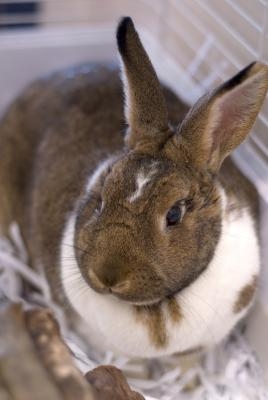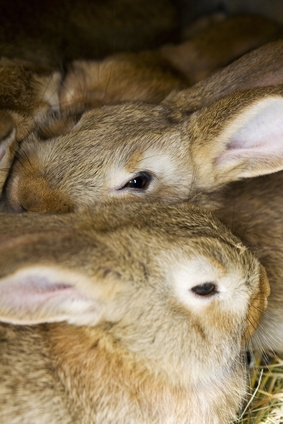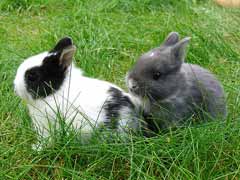
Rabbit cages can be expensive to buy but are not so difficult to build yourself. Also the materials are not expensive so that they can be replaced in the event of damage.
The larger the enclosure and the cage within it, the better. Maximising floor space should take priority over height when designing your rabbit cage.
An important point to note that might impact your design, is that pet rabbits should be allowed out of the cage and enclosure so that they have variety but also because they then come to regard the cage as their den, which makes them more comfortable using it.
Allow room for the litter box and internal feeding arrangements including bowls and toys.
The cage should be placed in positions that avoid temperature fluctuations. If exposed to sunlight, bear in mind the changing position of the sun through the year.
Wire floors, although sometimes found in commercial rabbit cages, should be avoided if possible as they can, over time, damage the feet of your rabbit.
A solid floor consisting of linoleum fastened onto a thick plywood base creates a strong solid floor that is easy to clean.
If the enclosure is going to be situated indoors, plastic or rubber feet can be added to the underside of the floor to reduce wear on carpets or floors.
The frame of the cage can be built from wood, which will be stronger than the workable alternative of using dowels to fasten sides together and to the floors. Metal brackets can be screwed into sides and corners.
Additional floors and ramps, if required, can again be built using plywood and linoleum. Similarly, a frame or dowels can be used. If building a second floor, the strongest frame would use single lengths of wood as corner pieces with notches cut in which to seat the edges of the additional floor.
Chicken mesh can be used for most if not all of the front of the cage. This is ideal for reducing build-up of odour by allowing air to circulate. Sharp ends or edges on the wire must be avoided. Rabbits will chew anything over a period of time, which is a further reason for avoiding the use of plastic anywhere in the cage if possible.
Octagon-shaped cages are popular, as are L-shaped cages with the litter box in the short leg of the L-shape. With adequate space, you could also consider adding a simple maze as variety for the inhabitants.
If situated outside, a sloping roof covered with weatherproofing felt is the optimum arrangement. It should be removable so that the inside of the cage can be easily accessed but secured against potential predators.
The above points cover the basics of building your own rabbit cage and demonstrate that it is not so difficult.
 The Safest Way to Disinfect a Used Rabbit Cage
The Safest Way to Disinfect a Used Rabbit Cage
The Safest Way to Disinfect a Used Rabbit Cage
The Safest Way to Disinfect a Used Rabbit Cage
 Directions on How to Build a Cage for an Outside Rabbit
Directions on How to Build a Cage for an Outsi
Directions on How to Build a Cage for an Outside Rabbit
Directions on How to Build a Cage for an Outsi
 How to Make a Rabbit Trap
How to Make a Rabbit Trap
How to Make
How to Make a Rabbit Trap
How to Make a Rabbit Trap
How to Make
 Homemade Rabbit Bedding
Homemade Rabbit Bedding
Homemade Rabbi
Homemade Rabbit Bedding
Homemade Rabbit Bedding
Homemade Rabbi
 Caring For Rabbits: Top 10 Tips To Help
If you
Caring For Rabbits: Top 10 Tips To Help
If you
Copyright © 2005-2016 Pet Information All Rights Reserved
Contact us: www162date@outlook.com